
|
Sale 72
February 2-5. 2013
| Lot |
Photo |
Description |
Realized |
Lot 1315 |
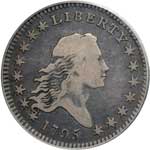 |
1795. . O-105, Rarity-4. PCGS graded Fine-12 PQ. Housed in an Old Green Holder. Nice even toning with contrasting deeper gray in the fields offset by lighter rubbed silver color on the highest design details. A lovely specimen. O-105 is from a vernerable Reverse C die where the berries are arranged 10 + 7, with two below the right wing (one inside, one outside). The defining feature of O-105's has two points of star 1 solid to the lowest curl, with a point of star 2 entirely across the end of the second curl (PCGS # 6052) .
Estimated Value $2,800 - 2,900.
View details and enlarged photos
Check results on similar lots
| Realized
$3,220 |
Lot 1316 |
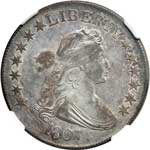 |
1807. . O-106, Rarity-3. NGC graded EF-45. Attractive grey toning. Advanced die cracks on the obverse, one of which joins the base of the date and to milling at left, a short vertical crack joins the end of the same to the extended crack from stars. On the reverse of this relatively common variety, there are 5 berries, with the upper berry half buried in a leaf.
Estimated Value $2,200 - 2,300.
View details and enlarged photos
| Realized
$2,530 |
Lot 1317 |
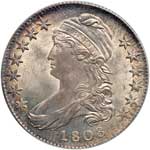 |
1808. . O-106a, Rarity-2. PCGS graded MS-66. CAC Approved PQ. Lovely golden toning on both sides. A coin that should set a record price. The finest 1808 Half we have ever seen. Lovely rose-gray and golden patina dances across pristine, heavily frosted surfaces. A semi-circular die crack that advances from top to bottom of the obverse is easily lost within the portrait, being diagnostic to pieces struck in the advanced state of the dies. The inner portion of the eagle's left wing (facing) is a trifle blunt, as usual. There is a solitary, dark toning spot in the horizontal stripes of the eagle's shield that should easily identify this exceptional, Condition Census 1808 half dollar. Pop 5; 4 finer in 67 (PCGS # 6090) .
History of the Capped Bust Halves (1807-36): John Reich's first assignment upon being made the Mint�s engraver was to create new designs for gold and silver denominations. The first ones to benefit from his attentions were the denominations most in demand at banks: half dollars and half eagles of 1807. According to the Breen encyclopedia, "Mint Director James Ross Snowden {1860}, using Mint documents not now located, said that the changeover occurred in Sept. 1807: [750,500], from four obverse and three reverse Reich dies. Critics at once attacked the design for portraying �the artist's fat mistress� (which may even have been true, though there is no evidence), and for having Ms. Liberty not only extravagantly buxom but wearing the pilleus, or liberty cap, on her head. For this the answer was immediate, as quoted by Thomas Jefferson in 1825: The cap was meant not for the pilleus but for a fashionable head covering of the time--specifically a mobcap, like the one found on portraits of Martha Washington but less elaborate and minus the veil." Reich's eagle was copied on United States infantry officers' buttons.
Half dollars were struck in every year and of every date except 1816. The mintage dated 1815 was delivered Jan. 10, 1816 only hours before a fire in one of the Mint's outbuildings ruined the rolling mills, making conversion of gold or silver bullion into standard planchets impossible until repairs were complete (late 1817). John Reich left the Mint March 31, 1817.
Estimated Value $22,000 - 25,000.
Ex Dawson, Heritage 9/1998.
View details and enlarged photos
Check results on similar lots
| Realized
$48,300 |
Lot 1318 |
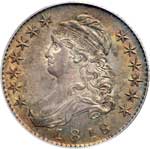 |
1818, 8 over 7. Large 8. PCGS graded MS-63. Nicely toned and well struck. Some reverse discoloration (PCGS # 6115) .
Estimated Value $3,500 - 3,700.
View details and enlarged photos
Check results on similar lots
| Realized
$6,325 |
Lot 1319 |
 |
1824. . O-117. PCGS graded MS-66. CAC Approved PQ. Boldly struck with lovely toning on both sides. Two mint-made spikes from the left (facing) wing identify this die pairing. One of the finest graded of this date by PCGS, tied with a few others, with a Mint State 68 graded higher by that service. Brilliant luster plus toning so beautiful on the obverse over especially bright luster one has to give it extra emphasis. The reverse similar, but rather than mostly golden color, now with lovely delicate blue and lilac toning throughout. Boldly struck making this high in the condition census for the variety, and date too! If you have long been searching for a really special coin, a spectacular offering, one that boasts original toning, and one that is very high grade, then look no further than this lot. One of the highlights of the Half Dollar section of the sale, and certain excite even the most advanced collector. Pop 6; 1 finer in 68 (PCGS # 6137) .
Estimated Value $10,000 - 12,000.
View details and enlarged photos
Check results on similar lots
| Realized
$28,750 |
Lot 1320 |
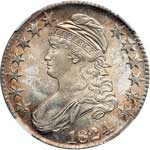 |
1824, 4 over 4. . O-110a, die break AM to right wing. NGC graded MS-65. Well struck and frosty with lovely light gold toning. On this later die state, the top of the 4 is barely visible to the left of the top of the prominent 4. This is undoubtedly among the finest known examples as the Condition Census in Overton's third edition is listed as (65, 65, 65, 64, 62). This exceptional coin is crisply detailed in the centers with the usual softness (as seen on this variety) on the peripheral stars. The surfaces are obviously original and each side is covered with dusky gray patina to dappled golden brown of rich color. Strong mint luster underlies the toning and is a dominant feature on this outstanding Gem O-110a half dollar. Pop 4; none finer at NGC .
Estimated Value $9,000 - 10,000.
Ex: Frank McCarthy Collection.
View details and enlarged photos
| Realized
$9,488 |
Lot 1321 |
 |
1829. . O-111a. Unique as a Proof. NGC graded Proof 63. CAC Approved PQ. Well struck with lovely golden toning. Only 8 minted. Pop 2; 3 finer, 2 in 65, 1 in 66
Since it would be difficult to improve upon the detailed description and provenance given by the Stack's auction cataloger in 2006, we append the description verbatim:
A coin of stunning beauty with rich golden-sunset toning over the entire surface with a touch of darker blue near the rims. The strike is bold on all the obverse stars, Liberty's curls and the eagle's talons, areas poorly defined on regular issue coins. It is curious that the coiner chose this die pair to strike a Proof coin, as the reverse was first used in 1828 for circulation strikes. Both the 'A-S in AMERICA are filled at the top as a tiny portion of the die chipped away during the 1828 coinage. The reverse die was used in 1829 as well for circulation strikes, which were struck prior to the present coin. These earlier circulation strikes show repunching on the 'STA' and 'E' of STATES. After striking this Proof example, additional circulation strikes were coined. Identifiable by a shallow nearly vertical nick near and left of the beak, and by the stunning quality of this specimen. The '9' shows repunching on the upper right, and center base.
The coiner prepared the obverse and reverse dies by frosting the devices, then polishing the fields to mirror reflectivity. During this process, the repunching on STATES disappeared, and the definition on the 'TY' of LIBERTY and the clasp were inadvertently weakened. The defining line of Liberty's bust above the date was partially polished away, and the curls and other devices were weakened by this process. Small areas of frost extend into the mirror fields, notably below Liberty's chin, around the ribbon tips on the obverse, and on the reverse close to the olive branch and leaves. The polishing is seen within the shield lines, but not in the letters of LIBERTY or the Motto, which display frosted depths as opposed to mirror reflectivity seen on some other Proofs of this era. Nevertheless, this specimen has the commanding presence expected for a Proof, with boldly frosted devices contrasting with highly reflective fields. NGC PR63.
The following is a census of the known Proof Half Dollars of 1829:
O.105. Proof. Phillip G. Strauss Collection, sold privately, seen by Walter Breen in 1951. No auction appearance known.
O.107. NGC PR66. Wayte Raymond; Hillyer Ryder; The John J. Pittman Collection (David Akers, May 1998, lot 1491); Sebring Collection (American Numismatic Rarities, January 2004, lot 1473).
O.108. Proof 63/64. The Norweb Collection (Bowers and Merena, November 1988, lot 3095).
O.111a. NGC PR63. The Present Specimen. Schulman Collection; Globus Collection; Stack�s Auction, December 1998, lot 1362.
O.112. Proof 63. Norweb Collection (Bowers and Merena, November 1988, lot 3097); Logan/Steinberg Auction (Bowers and Merena, November 2002, lot 1462).
Other appearances are untraced and include Newcomb I:744; Woodin:173; Reed Hawn:91; ''Dupont'':2088 to Kagin; 1829/7 is likely the present coin above with the repunched '9' reported as an overdate by Wayte Raymond (PCGS # 6208) .
Estimated Value $30,000 - 40,000.
Ex Schulman, Globus, Stack's 10/2006.
View details and enlarged photos
Check results on similar lots
| Realized
$42,550 |
Lot 1322 |
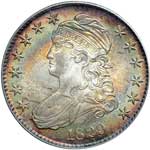 |
1829. . O-115, Rarity-1. PCGS graded MS-65. Lovely rainbow toning on both sides. The variety is fairly quickly spotted, due to the following: Stars sharp and close to milling. The 5[0] has a short top with upturned tip. Arrowheads separated and the lower one is recut at the upper back side near the shaft. The inner border of the shield on the left extends into feather at bottom. Right side of I under left side of T. Base of second T in STATES higher than A and E.
This piece is simply over the top in terms of eye appeal. The wonderful patina features pastels of many colors predominating throughout, with radiant cartwheel luster over well-struck surfaces. In MS65 this piece would appear to be well within the Condition Census for the variety, and one of the finest available at least among recent sales as enumerated in auction references. Pop 16; 3 finer in 66
(PCGS # 6154) .
Estimated Value $6,000 - 6,500.
View details and enlarged photos
Check results on similar lots
| Realized
$14,950 |
Lot 1323 |
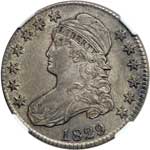 |
1829, 9 over 7 Overton-101A Rarity 1. NGC graded AU-53. Even toning. A pleasing example of this clear overdate.
Estimated Value $500 - 550.
View details and enlarged photos
| Realized
$575 |
Lot 1324 |
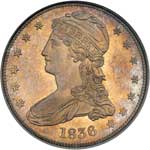 |
1836. Reeded Edge. PCGS graded Proof 64 Cameo. CAC Approved. Only 12 examples minted. Designer Christian Gobrecht. Lovely golden toning on both sides. The 1836 Reeded Edge Half Dollar has often been mislabeled a Pattern. Since the time of R. C. Davis's original articles on Patterns in The Coin Collector's Journal in the 1880s this has been the case. Robert W. Julian established in 1982 that, in addition to a very small production run (non-Proof) on November 8, 1836, further quantities were struck in December of that year. The total minted in 1836 was unquestionably low due to difficulties with the new steam press, probably mostly due to ejection failures. The specimens struck in November and December would, without question, have been struck at the old weight and fineness since that was the only legal basis on which they could have been struck prior to passage of the new Act of January 19, 1837. These would thus have weighed 208 grains and had a fineness of .8924 silver. The pieces struck early in 1837--and forming part of the delivery of February 22, Washington's birthday and the first anniversary of the "First Steam Coinage" token and probably not a randomly chosen date -- would have been on the new 206-1/4 grain.900 Fine standard as were the 1837 strikes of the 1836-dated Gobrecht Dollar. Both the December 1836 and the February 1837 issues were struck for, and released to, circulation through normal channels.
Based on Mint delivery figures for December 1836, and for the first half of 1837, as well as on the relative ratios of the two weights for specimens whose weights are known to us, it is believed that some 200 Halves were struck and delivered in December (on the old standard), and 1,000 more in February 1837 (struck on the new standard). Since the weight differential between the two issues was only one and three-quarters grains, circulation would quickly blur the distinction.
The Mint had been using stem power in the production of large Cents since March 1835, the first Half Dollars were not struck on one of the new steam-powered presses until November 8, 1836. The first coins of this denomination using the new technology were a few dozen Proofs of the new Reeded Edge design. Mint Director Levi Woodbury sent some, if not all of these specimens to Secretary of the Treasury Levi Woodbury. The Proofs were followed by approximately 1,200 business strikes. Such a limited original mintage explains why the 1836 is one of the most eagerly sought, key-date issues in the entire U.S. Half Dollar series.
Perhaps surprisingly for a Proof, the 1836 Reeded Edge Half is typically seen with isolated striking incompleteness. Such is definitely not the case with the present example, for on the obverse the star centers are all well impressed. The balance of the devices, too, are bold-to-sharp in definition. Both sides are developed rich toning over time in pale lilac to golden russet shades that swith to almost silvery-steel iridescence at the rims. Direct angles call forth the underlying mirror surface. Close inspection with a loupe reveals only one or two trivial handling marks. Among the latter features is a thin, wispy line by the eagle�s neck feathers at right and a little roughness in the field left of the beak that should serve as a useful provenance markers. Richly original in appearance, with undeniable rarity and tremendous collector appeal. Pop 2; 1 finer in 64+CAM (PCGS # 86223) .
The name of Gobrecht, the third person to occupy the post of chief engraver at the Philadelphia Mint and the designer of this 1836 Reeded Edge Half Dollar, is well known to collectors today and is reflected in such popular terms as Gobrecht dollar and The Gobrecht Journal, the latter being the publication of the Liberty Seated Collectors Club. Among pattern coins his contributions are at once important, beautiful, and extensive. Most familiar are his Liberty Seated coins, first made in pattern form in 1836, and continued across the denominations of half dime, dime, quarter dollar, half dollar, and silver dollar for years thereafter. Throughout the middle range of the last century, the Liberty Seated obverse as well as Gobrecht's perched eagle reverse were used as obverse and reverse dies for hundreds of different pattern varieties, often with the other die being the work of James B. Longacre or one of the Barbers.
Separately, Gobrecht's flying eagle is an American numismatic icon. First used on the 1836 pattern dollar, it later appeared on many other patterns as well as regular issue 1857-1858 cents.
Not only did Gobrecht's designs stand on their own, but they spawned many later versions by others, including Liberty Seated figures created by Longacre, William Barber, and possibly even by J.A. Bailly.
Estimated Value $70,000 - 80,000.
View details and enlarged photos
Check results on similar lots
| Realized
$66,125 |
Lot 1325 |
|
An Old Time Collection of Bust Halves 1809 to 1836. Grades range from Good to VF. Some have been cleaned. Lot of 25 coins.
Estimated Value $1,000 - 1,250.
View details
| Realized
$2,128 |
Lot 1326 |
|
A Lot of ANACS Slabbed Bust Half Dollars. Dates and grades include: 1812 XF40, 1825 XF45, 1826 XF45, 1829 XF45, 1831 XF45, and 1834 XF45. Lot of 6 coins.
Estimated Value $500 - 600.
View details
| Realized
$978 |
Lot 1327 |
|
A Lot of Bust Half Dollars. Dates range from 1823 to 1836 and coins grade VF to XF . Lot of 7 coins.
Estimated Value $700 - 800.
View details
| Realized
$920 |
Lot 1328 |
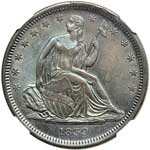 |
1839. No Drapery. NGC graded MS-67. Perhaps the Finest Known. Well struck with lovely blue toning. After a long, illustrious run from 1807 to 1836, the Mint switched to a more modern design in 1839 with introduction of the Seated Liberty motif (1839-91). The first-year 1839 was made in two versions, No Drapery at Liberty�s elbow and With Drapery. The one-year No Drapery half dollar is a popular issue for that reason, one eagerly acquired by Type and Seated Half Dollar set collectors both. Even high-end circulated specimens and lower-Mint quality examples are popular at auctions. It goes without saying at the Superb Gem grade of the current specimen, the remarkable condition of MS67 elevates it to the status of a famous rarity. This coin is the sole coin in its class certified at NGC, and indeed, surpassing lesser pieces by two grade points! (At the MS65 level, NGC has only graded two.) The situation repeats at PCGS, where two MS65s are recorded.
Designed by Christian Gobrecht, the first appearance of the Seated Liberty design occurred in 1836 on the silver dollars. Later, half dimes and dimes received the nod in 1837, the quarter dollars in 1838, and finally the half dollar denomination in 1839. The concept for a seated allegorical figure goes all the way back to Ancient times (Rome and Greece), so the concept was older still. These were struck on the newly introduced (1836) Thonnelier steam press which enabled faster production, and more uniform coins to be produced. The steam press was first used in 1836 on the rare Reeded Edge half dollars (only 1,500 being struck).
A total of 1.97 million 1839 No Drapery half dollars were made in for circulation, along with four known Proofs. Mint States of the 1839 No Drapery are of considerably rarer than most early collectors realized. With the advent of third-party grading in the 1980s it was revealed that fewer than four dozen certified in all Mint State grades between NGC and PCGS have passed through the grading procedure. More than one reverse die was used, including one that has die breaks. The present MS67 specimen is from a die showing no deterioration in the form of breaks.
Offered two years ago in a Heritage sale of 2011, the cataloger of the piece described the coin�s superior status in clear terms: "What is present on this coin in abundance, however, is marvelous aesthetic appeal. Both sides appear to have acquired their lovely patina naturally over a long period of time, in shades of lilac and blue at the centers, complementing lighter tinges of pinkish at the rims. The strike is not quite full but is extremely bold nonetheless, with marvelous detailing on Liberty's hair, gown, and shield, and the eagle on the reverse. Only a couple of peripheral stars are incomplete. Both sides appear virtually free of post-Mint contact, although we see a tiny depressed planchet flaw in the reverse field, just above HA(LF). A powerfully appealing example of this issue, and the single finest known of this historic first-year type." Pop 1; none finer at NGC .
1839: Those were the days. A colorful character who has since dropped out of history made front-page news the year of this Half Dollar. In 1839, the first woman horse thief in America published her confessions. Josephine Amelia Perkins, born and raised in England, stole her first horse from her own father for her elopement. Eventually she came to America completely broke, and continued her career of horse-stealing. She herself admitted to being "4 times detected, twice pardoned on account of my sex, once for reasons of supposed insanity, and the 4th and last time, convicted and sentenced to 2 years imprisonment in Madison County jail, Kentucky." (The report doesn�t say whether or not she later ran for Congress.)
Continuing on the subject of the fair sex, the Mar. 3, 1839, New York Mirror ran the following as a program for a dinner conversation: "When you are seated next to a lady, you should be only polite during the 1st course; you may be gallant in the 2nd; but you must not be tender till the dessert."
Estimated Value $100,000 - 115,000.
View details and enlarged photos
| Unsold |
Lot 1329 |
 |
1841-O Large O WB-11. PCGS graded AU-58. Light golden toning, a scarce desirable offering in this outstanding grade. Excellent surfaces, ideal eye-appeal. Only minor weakness in the strike on the right wing of the eagle (PCGS # 6237) .
Estimated Value $1,200 - 1,250.
View details and enlarged photos
Check results on similar lots
| Realized
$1,438 |
Lot 1330 |
 |
1862. NGC graded Proof 67 Star Cameo. A white gem with a hint of gold tone near the edges. Only 550 minted. Like few Proof Seated Half Dollars available today, this coin exhibits extraordinary quality for a coin struck during the depths of the Civil War, 1861-65. The obverse has vibrant amber-golden toning along the periphery on both sides with an addition of lovely steel-blue iridescence. Both sides retain full original brilliance from the dies after 151 years! Outstanding quality, this is tied with one other NGC Proof 67 Star Cameo as the finest certified by this key grader. Pop 2; none finer at NGC .
Prior to becoming the 16th President, Honest Abe Lincoln, a top money earning Illinois railroad lawyer, invested in land in Council Bluffs, Iowa in 1857. To this day this piece of land is known as "Lincoln�s Hill." When he became president one of his first official acts was to call a special session of Congress to begin work on the Pacific Railway Act that would shower railroad corporations with government subsidies while they built a transcontinental railroad line for the nation, a world-class undertaking. When Congress finally passed the bill in 1862 it gave the president the right to decide the eastern terminus of the line. And guess what? Lincoln chose Council Bluffs, Iowa. Some say it was a coincidence. Others call it an example of savvy political insider trading.
Estimated Value $15,000 - 16,000.
View details and enlarged photos
| Realized
$19,550 |
Lot 1331 |
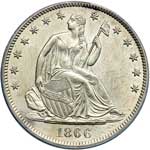 |
1866-S. No motto. PCGS graded MS-62. Frosty and untoned. This is a sharply struck example that has clean surfaces and a rich silvery sheen for the patina, luster that is spread evenly over each side including the high points of the design. There is no die clashing present on the reverse, which adds to the desirable quality since a number of these were made from clashed dies. One expert, Dick Osburn, who has studied this date extensively, estimates that perhaps only one in twenty 1866-S No Motto Halves show no die clashing on the reverse.
It took some time before the Philadelphia Mint could prepare new dies incorporating the new IN GOD WE TRUST motto. Being the sole source for dies for the branch mints, Philadelphia had to send an old No Motto reverse to San Francisco in 1866 since the With Motto versions weren't ready. Travel in those days was slow, at best. It was not until May 1866 that the new Half Dollar reverses went out. Before they arrived, however, San Francisco's coining department struck 60,000 No Motto Halves. It is likely fewer than a dozen Mint State specimens survive, making 1866-S No Motto an undeniable rarity in the grade. Pop 1; 2 in 63, 1 in 65 (PCGS # 6315) .
Estimated Value $14,000 - 15,000.
View details and enlarged photos
Check results on similar lots
| Unsold |
Lot 1332 |
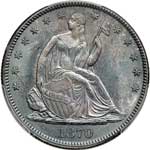 |
1870. PCGS graded MS-63. CAC Approved PQ. Nice even toning and lustrous. Pop 8; 10 finer, 5 in 64, 1 in 64+, 3 in 65, 1 in 67 (PCGS # 6327) .
Estimated Value $650 - 700.
View details and enlarged photos
Check results on similar lots
| Realized
$1,006 |
Lot 1333 |
|
A Lot of U.S. Half Dollars 1837 to 1870's. Grades range from Poor to VG. Lot of 31 coins.
Estimated Value $500 - 600.
View details
| Realized
$1,265 |
Lot 1334 |
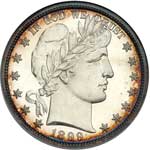 |
1899. NGC graded Proof 68 Star Cameo. Mostly untoned except for light gold tone on the edges. Proof mintage was only 846 pieces. This is an extraordinary coin by any measure, whether a person considers it from the standpoint of technical merit, or when judged according to the subjective values of purely visual aesthetics. Need we remind bidders that a weak impression could never be left after the rebound of the dies that usually struck this date, since the mint would not have released it to a buyer; in the present case, the strike depth, the amount of detail this coin shows, is outstanding and crystal clear, a truly bold strike. Not even the tiniest mark or planchet imperfections seems evident. The surfaces are nicely balanced with silvery shades, allowing for a little colorful toning at the extreme edge. Whatever your opinion of the merits of the Barber design of 1892-1915, and many agree it is one of our most distinctive coin designs of the 19th century, everyone is bound to admit this is an exquisite Proof specimen in every respect, and certainly among the finest known. Pop 2; none finer at NGC .
Estimated Value $9,000 - 10,000.
View details and enlarged photos
| Realized
$11,500 |
Lot 1335 |
 |
1907. NGC graded Proof 65. A hint of gold tone. Only 575 struck. Frosty white patina dominates both sides beneath the toning. If you were expecting the design left by the Proof dies to be deficient in robustness, take heart, since this is an exceptional Barber Half Dollar and not the a sometimes run-of-the-mill business strike but a gleaming Gem Proof. It is, indeed, very bold. Pop 54; 69 finer.
Estimated Value $2,500 - 2,600.
View details and enlarged photos
| Realized
$2,818 |
Lot 1336 |
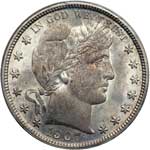 |
1907-S. PCGS graded MS-64. Toned on the obverse. For many years the price of the 1907-S Barber half dollar failed to reflect its true scarcity in choice Mint State condition. With the auctions over the past decade and the cumulative data provided by the grading services, collectors began to realize just how rare a given date is in any particular grade. In this attractive MS64 condition there are very few examples graded, and if a collector is lucky, a handful of specimens of various qualities may appear at auction in any given year. Pop 8; 14 finer (PCGS # 6511) .
Estimated Value $8,000 - 8,400.
View details and enlarged photos
Check results on similar lots
| Unsold |
Lot 1337 |
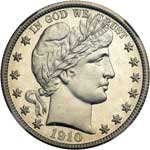 |
1910. NGC graded Proof 64+. A nice white coin and a scarce one at that since mintage fell toward the low end of the sale within the 1892-1915 Proof Barber Half Dollar series. Only 551 minted. Pop 3; 86 finer.
Estimated Value $1,700 - 1,800.
View details and enlarged photos
| Unsold |
Lot 1338 |
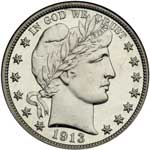 |
1913. NGC graded Proof 66 Cameo. A nice white coin. Only 627 minted. A gleaming silver-bright coin with no objectionable hairlines or toning spots. As soon as one sees the booming luster, it comes as no surprise everything is razor-sharp on all devices. Pop 4; 4 finer .
Estimated Value $4,500 - 4,700.
View details and enlarged photos
| Unsold |
Lot 1339 |
|
A Lot of Key Date Barber Half Dollars. Consists of: 1913 (5), 1914 (5), and 1915 (5). All in Good condition. Lot of 15 coins.
Estimated Value $1,000 - 1,100.
View details
| Realized
$1,093 |
Lot 1340 |
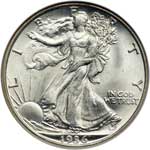 |
1936-D. NGC graded MS-67. A frosty white coin. Untoned with blazing satin-sheen luster that avoids the usual microscopic marks on the attractively frosted central devices. We have mentioned the luster. In winding up this description, we point to it being a strongly struck P-mint coin, one of the best made in the series compared with the often so-so branch mint strikes, a coin with extra sharp detail to all the important high points. Pop 25; 1 finer in 67 Star .
Estimated Value $3,200 - 3,300.
View details and enlarged photos
| Realized
$3,163 |
Lot 1341 |
 |
1937. NGC graded Proof 64. A nice brilliant coin. Only 5,728 minted.
Estimated Value $600 - 650.
View details and enlarged photos
| Realized
$719 |
Lot 1342 |
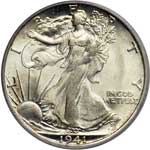 |
1941-S. PCGS graded MS-66+ CAC Approved. A hint of gold toning. Almost full strike on Liberty's leg and hip. Scarce when well struck. Pop 16; 6 finer in 67 (PCGS # 6613) .
Estimated Value $3,800 - 3,900.
View details and enlarged photos
Check results on similar lots
| Unsold |
Lot 1343 |
|
A Lot of Walking Liberty Half Dollars 1916 to 1930s. Many of the semi key dates in this lot. Coins will grade AG to VF. A careful study is recommended. A total of $69 face value .
Estimated Value $1,600 - 1,700.
View details
| Realized
$2,473 |
Lot 1344 |
|
A Lot of Better Date Walking Liberty Halves. Consists of: 1916 (4), 1916-D (4), 1916-S (2), 1917-D Obverse (6), 1917-S Obverse (6), 1917-S Reverse (1), 1918 (1), 1918-S (1), 1921 (2), 1921-S (9), and 1938-D (1). Coins will grade About Good to VG. Lot of 37 coins.
Estimated Value $700 - 800.
View details
| Realized
$978 |
Lot 1345 |
|
A Set of Walking Liberty Half Dollars 1916 to 1947-D. Coins grade About Good to XF. Housed in a Littleton Custom Coin Album.
Estimated Value $600 - 700.
View details
| Realized
$891 |
Lot 1346 |
|
A Set of Walking Liberty Half Dollars 1916 to 1947-D. Coins grade About Good to XF. Housed in a Littleton Custom Coin Album.
Estimated Value $600 - 700.
View details
| Realized
$920 |
Lot 1347 |
|
A Holding of Walking Liberty Half Dollars 1930s to 1947. This group will grade XF to Unc. A total of $79 face value .
Estimated Value $1,700 - 1,900.
View details
| Realized
$2,846 |
Lot 1348 |
|
A Group of Walking Liberty Half Dollars. Dates range from 1934 to 1946 and grades range from AU to BU. A nice lot that should be looked over carefully. Some gems in this lot. Lot of 38 coins.
Estimated Value $800 - 900.
View details
| Realized
$978 |
Lot 1349 |
|
Walking Liberty Half Dollar Set 1941 to 1947-D. PCGS graded all MS-65. All housed in First Generation Holders. The following dates are CAC Approved: 1941-D, 1941-S, 1942-S, 1943-D, 1943-S, 1944, 1945-S, and 1947-P. The following dates have Gold CAC stickers: 1942-D, 1944-D, and 1946-S. An incredible set! Lot of 20 coins.
Estimated Value $4,000 - 4,500.
View details
| Realized
$5,750 |
Lot 1350 |
|
A Set of Walking Liberty Half Dollars 1941 to 1947-D. PCGS graded all MS-65. Lot of 20 coins.
Estimated Value $2,800 - 3,000.
View details
| Unsold |
Lot 1351 |
|
A Lot of Common Date Walking Liberty Half Dollars. Coins grade VF to AU. A total of 71 coins. The total face value is $35.50.
Estimated Value $700 - 750.
View details
| Realized
$920 |
Lot 1352 |
|
A Set of Walkers 1941 to 1947-D. Housed in a Dansco Album and grades range from MS60 to MS64. Lot of 20 coins.
Estimated Value $700 - 750.
View details
| Realized
$605 |
Lot 1353 |
|
A Lot of PCGS graded MS65 Walking Liberty Half Dollars. A total of 19 common date coins.
Estimated Value $1,400 - 1,500.
View details
| Realized
$1,754 |
Lot 1354 |
|
A Lot of PCGS graded MS64 Walking Liberty Half Dollars. Lot of 20 coins.
Estimated Value $1,000 - 1,050.
View details
| Realized
$1,208 |
Lot 1355 |
|
A Lot of Slabbed Walking Liberty Half Dollars. Consists of: NGC MS65 (3), NGC MS64 (4), PCGS MS64 (2), and ANACS MS64 (2). Lot of 11 coins.
Estimated Value $500 - 550.
View details
| Realized
$690 |
Lot 1356 |
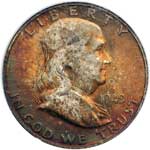 |
1949-D. NGC graded MS-64. Lovely golden toning. From an original mint set and it shows. A beautiful coin.
Estimated Value $500 - 525.
View details and enlarged photos
| Unsold |
Lot 1357 |
|
A Lot of PCGS and NGC Slabbed Franklin Half Dollars Also Some Ungraded. Consists of: PCGS graded; 1956 PR67, 1962 PR67 (2), 1963 PR67CAM, 1953-S MS65 (3), 1954 MS64FBL (4), 1955 MS65, 1956 MS65, 1957 MS65, 1958 MS65, NGC graded; 1948 MS64FBL, 1956 MS64FBL (5), Ungraded Proofs; 1961 (4), 1962 (13), 1963 (4), Ungraded Uncs; 1963 (20). A nice lot of 63 coins.
Estimated Value $600 - 650.
View details
| Realized
$1,265 |
Lot 1358 |
|
A Set of BU Franklin Half Dollars 1948 to 1963-D. Housed in a custom lucite holder.
Estimated Value $500 - 550.
View details
| Realized
$604 |
Lot 1359 |
|
A Lot of Franklin Half Dollars 1948 to 1950s. Many are in Unc condition and this lot should be carefully examined. A total of $59.50 face value .
Estimated Value $1,300 - 1,400.
View details
| Realized
$1,668 |
Lot 1360 |
|
A Near Complete Set of Proof Franklin Half Dollars 1950-1963. Housed in a Capital Plastics holder. Missing the 1953. Lot of 13 coins.
Estimated Value $700 - 800.
View details
| Realized
$834 |
Lot 1361 |
|
A Lot of NGC Slabbed Proof Franklin Half Dollars. Consists of: 1955; PF67, PF68, PF69, 1956 Type 2; PF67, PF68 (4), PF69 (3), PF69 Star, 1957; PF67 (5), PF68, 1958; PF67 (4), PF68 (2), 1959; PF67 (2), PF68 (2), 1960; PF67, PF68, PF68 Star (2), 1961 PF67 (2), PF68 (2), PF68CAM (2), 1962; PF67 (8), PF68 (3), PF68CAM (4). A nice lot of 53 Proof Franklin Halves.
Estimated Value $600 - 700.
View details
| Realized
$4,140 |
Lot 1362 |
|
A Lot of Proof Franklin Half Dollars Dating 1960 to 1963. Lot of 83 coins.
Estimated Value $750 - 800.
View details
| Realized
$1,047 |
Lot 1363 |
|
A Group of U.S. Half Dollars. Consists of: Bust Halves 1809 to 1836 Poor to VF a few with holes (9), Seated Halves 1840 to 1870's Poor to VF some with holes (15), and Barber Halves 1892 to 1915 Fair to Fine with some better dates (17). A total of 41 coins with some better items included.
Estimated Value $900-UP.
View details
| Realized
$1,323 |
Lot 1364 |
|
A Lot of U.S. Half Dollars. Consists of: Barber Halves with some better dates (7), 1915-S Pan Pac 50¢ XF cleaned (1), 1920 Pilgrim Commem XF (1), 1935-D Arkansas Commem VF cleaned (1), Franklin Halves 1949-1955 mostly Unc (11), 1970-D Unc (2), 1998-S Unc (1), late date commems (5), a partial set of Franklins 1948 to 1954-S all Unc and nicely toned (19 pieces), 1957 PCGS PR66 (1), 1960 PCGS PR68 (1), 1963 NGC PF66CAM (1), and 1917 PCGS AU58 (1). A nice lot.
Estimated Value $800 - 900.
View details
| Realized
$1,725 |
|
|